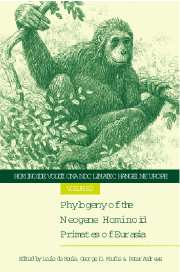 Hominoid Evolution and Climatic Change in Europe
Hominoid Evolution and Climatic Change in Europe Book contents
- Frontmatter
- Contents
- List of Contributors
- Acknowledgements: The European Science Foundation
- PART I: Chronology and environment
- PART II: Methods and phylogeny
- PART III Miocone hominoids: function and phylogeny
- 8 Eurasian hominoid evolution in the light of recent Dryopithecus findings
- 9 Functional morphology of Ankarapithecus meteai
- 10 African and Eurasian Miocene hominoids and the origins of the Hominidae
- 11 Phylogenetic relationships of Ouranopithecus macedoniensis (Mammalia, Primates, Hominoidea, Hominidae) of the late Miocene deposits of Central Macedonia (Greece)
- 12 Phylogeny and sexually dimorphic characters: Canine reduction in Ouranopithecus
- 13 Heterochrony and the cranial anatomy of Oreopithecus: some cladistic fallacies and the significance of developmental constraints in phylogenetic analysis
- 14 The late Miocene hominoid from Georgia
- 15 Forelimb function, bone curvature and phylogeny of Sivapithecus
- 16 Sivapithecus and hominoid evolution: some brief comments
- Index
12 - Phylogeny and sexually dimorphic characters: Canine reduction in Ouranopithecus
from PART III - Miocone hominoids: function and phylogeny
Published online by Cambridge University Press: 06 January 2010
- Frontmatter
- Contents
- List of Contributors
- Acknowledgements: The European Science Foundation
- PART I: Chronology and environment
- PART II: Methods and phylogeny
- PART III Miocone hominoids: function and phylogeny
- 8 Eurasian hominoid evolution in the light of recent Dryopithecus findings
- 9 Functional morphology of Ankarapithecus meteai
- 10 African and Eurasian Miocene hominoids and the origins of the Hominidae
- 11 Phylogenetic relationships of Ouranopithecus macedoniensis (Mammalia, Primates, Hominoidea, Hominidae) of the late Miocene deposits of Central Macedonia (Greece)
- 12 Phylogeny and sexually dimorphic characters: Canine reduction in Ouranopithecus
- 13 Heterochrony and the cranial anatomy of Oreopithecus: some cladistic fallacies and the significance of developmental constraints in phylogenetic analysis
- 14 The late Miocene hominoid from Georgia
- 15 Forelimb function, bone curvature and phylogeny of Sivapithecus
- 16 Sivapithecus and hominoid evolution: some brief comments
- Index
Summary
Degrees and patterns of morphological sexual dimorphism are problematic characters for the purpose of phylogenetic analysis. Since sexual dimorphism is a product of at least partly independent selection in males and females – although the underlying genetics of certain characters can produce a correlated response (Plavcan, 1998) – the relative contributions of male and female values to any measure of sexual dimorphism will vary. For example, species of Hylobates and Callicebus both have very minimal canine size dimorphism (Plavcan & van Schaik, 1992), but in Hylobates this is achieved through female canine hypertrophy, whereas in Callicebus it results from male canine reduction (Plavcan et al., 1995). Therefore, similar or identical measures of sexual dimorphism will not necessarily be homologous and can instead reflect homoplasy. Moreover, even sexual dimorphisms that reflect similar contributions from male and female values in the different species can still result from homoplasy; species of Hylobates and the Pitheciinae all express low levels of canine size dimorphism as a result of female canine hypertrophy, but this has clearly evolved independently in the two lineages. While the possibility of homoplasy exists for any character, it has quite clearly been especially common with respect to sexual size dimorphism, including canine size dimorphism, both within and between higher primate lineages.
While sexual dimorphisms as a class of characters offer poor prospects for phylogenetic reconstruction, it is nevertheless legitimate to explore the phylogenetic significance of morphological characters that happen to be sexually dimorphic. However, this can only be done in males and females separately since, by definition, males and females express different states for sexually dimorphic characters.
- Type
- Chapter
- Information
- Hominoid Evolution and Climatic Change in EuropePhylogeny of the Neogene Hominoid Primates of Eurasia, pp. 269 - 283Publisher: Cambridge University PressPrint publication year: 2001
- 6
- Cited by


